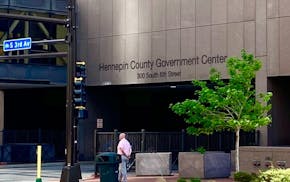Minnesota is set to spend historic sums on the environment after lawmakers agreed to a package of policy changes and programs to safeguard air and water, plant trees and renovate crumbling outdoor infrastructure such as fish hatcheries and boat ramps.
The $2 billion environment, natural resources, climate and energy bill that lawmakers reached agreement on Tuesday night is expected to head to Gov. Tim Walz's desk after House and Senate floor votes. The far-reaching changes will touch much of the state — its farm fields, grasslands, peatlands, forests, factories and homes.
The deal imposes one of the broadest bans on PFAS, the so-called "forever chemicals," and gives the state more power to punish irrigators who deplete groundwater. It provides money to taconite plants to filter out mercury pollution and new incentives for Minnesotans to buy electric vehicles.
Some measures sought by environmentalists, such as a ban on lead fishing tackle, didn't survive. Still, the Legislature's actions this session — aided by a DFL trifecta at the Capitol, a massive surplus and an influx of federal climate money — earned praise from activists for its scope.
"This is absolutely a landmark session," said Justin Fay, head lobbyist at Fresh Energy, a St. Paul renewable energy advocacy group. "It is unquestionably the most productive state legislative session ever in addressing climate change."
Most of the $1 billion in new spending comes from the state's general fund surplus but there are other sources too, such as the $11 million the state Department of Natural Resources (DNR) will generate from fee hikes — primarily boat registration fees that haven't been raised since about 2006.
The environment deal follows the clean energy law Walz signed in February that requires all of the electricity used in Minnesota to come from carbon-free sources by 2040.
Rep. Rick Hansen, DFL-South St. Paul, who helped negotiate the package, called it a strong foundation for future work.
"This is the most significant environment bill in Minnesota history, in both investments and reforms," he said.
Paul Austin, executive director at Conservation Minnesota, called the PFAS restrictions "a really big deal."
Per- and polyfluoroalkyl substances, called PFAS, have been widely used for fire suppression, to repel oil, water and stains and as components in some cosmetics and personal care items like dental floss. The substances can linger for years in the human body and have been linked to cancers and reproductive problems.
The bill imposes a ban on PFAS compounds in certain products as early as 2025, and a total phase-out by 2032 unless they are given a specific exemption.
Minnesota Pollution Control Commissioner Katrina Kessler said effects from the accelerated work on PFAS should come fast. She noted one component that advances environmental justice: Her agency must consider the cumulative impacts of pollution on certain disproportionately affected communities when issuing air-pollution permits to facilities in the seven-county metro area, Duluth and Rochester.
"I'm very pleased with where we landed," Kessler said. "I think it provides transformational investment opportunities ... on some of the highest priority environmental issues facing Minnesotans at this moment."
Here are some details of the new spending in the environment and energy package:
- $308 million for the Department of Natural Resources for reforestation, and to modernize crumbling fish hatcheries, boat ramps and state park buildings, among other facilities.
- $100 million in grants and technical assistance to help cities deal with the changing climate.
- $115 million for a new state fund to provide money for energy projects, including for deploying more renewable power and bolstering the electric grid.
- $84 million to improve soil health practices, hold water back on fields and restore grasslands and peatlands.
- $15.7 million over two years for the first-ever state rebates for electric vehicles: $500 for used and $2,500 for new.
- Nearly $20 million for taconite companies to install technology to reduce mercury emissions.
- $20 million for the Minnesota Climate Innovation Authority, a "green bank" aimed at difficult-to-finance energy projects.
- $15 million to renovate a power line from Hermantown to central North Dakota.
- $13 million in rebates to lower income residents for heat pumps, which use electricity instead of natural gas to heat buildings.
- $9 million for rebates to lower-income residents to upgrade electric panels. It's aimed at easing conversions from gas appliances to electric ones.
Lawmakers also took steps to better protect the state's groundwater, giving the DNR authority to issue stiffer penalties for breaking groundwater pumping permits or drawing water without one.
During the 2021 drought hundreds of farms and some cities pumped far more water — up to tens of millions of gallons — than permitted. Any potential penalties for taking the extra water, however, were required under the law to be forgiven as soon as the excessive pumping ended. Lawmakers will now allow the DNR to fine users up to $40,000 for breaking permits and have more discretion over whether to forgive penalties.
Some priority measures didn't survive. Negotiators declined to reinstate a citizens' board that once oversaw pollution permits at the MPCA after a group of rural House Democrats said they couldn't support the bill with that provision. The Legislature abolished the board in 2015 after the oversight group voted for an in-depth environmental review of an expansion of Riverview Dairy, the state's largest milk producer.
Lawmakers also decided against installing a new barrier to prevent invasive carp from spreading farther up the Mississippi River. After a record number of the destructive fish were caught this spring, senators pushed a $17 million proposal to install a noise, light and bubble system to act as a barrier along one of the river's lock and dams.
Legislators also jettisoned a proposed ban on lead sinkers and instead chose to spend $1 million to keep "Get the Lead Out" — an educational effort to get hunters and anglers to voluntarily switch to nontoxic ammunition and tackle. The program had been funded with settlement money from the BP oil spill in the Gulf of Mexico, funding set to expire this year.
Lead sinkers and jigs are swallowed each year by loons and swans, killing them. Lead bullets fragment inside deer, contaminating meat that hunters donate to food pantries or bring home. The lead fragments also kill eagles and other animals that scavenge gut piles.
"It's a baby step in the right direction," said Carrol Henderson, retired head of the DNR's nongame wildlife program who has promoted the replacement of lead for years. "It's a snail's pace, but the industry realizes that we have to switch from lead and we have to keep educating the public."

'Red alert': Researchers say Minneapolis is failing in response to domestic violence calls

After barrage of gunfire, neighbors, city officials take critical look at Boom Island Park safety

Bushel Boy, Minnesota's local tomato grower, sold
Federal agents surround south Minneapolis restaurant, clashing with protesters
